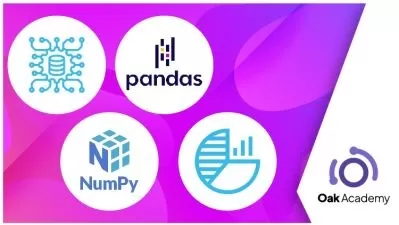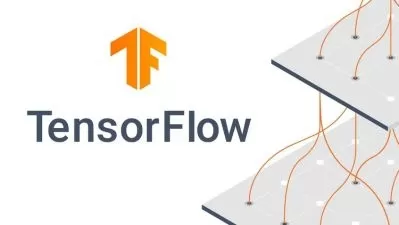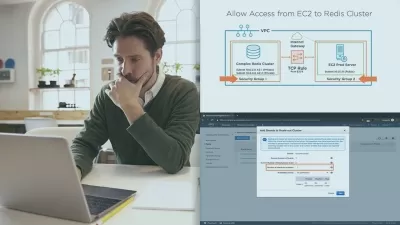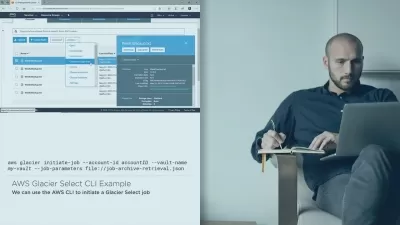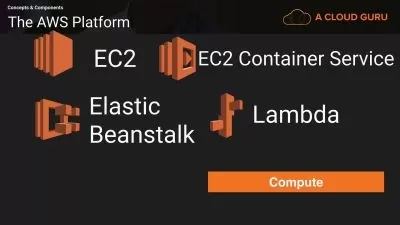AWS Certified Machine Learning – Specialty (MLS-C01) - 2023
Manifold AI Learning ®
34:00:24
Description
AWS Certified Machine Learning – Specialty (MLS-C01) - 2023 ,Sagemaker , AWS MLOps, Data Engineering, Exam Ready Updated
What You'll Learn?
- Select and justify the appropriate ML approach for a given business problem
- Identify appropriate AWS services to implement ML solutions
- Design and implement scalable, cost-optimized, reliable, and secure ML solutions
- The ability to express the intuition behind basic ML algorithms
- Performing hyperparameter optimisation
- Machine Learning and deep learning frameworks
- The ability to follow model-training best practices
- The ability to follow deployment best practices
- The ability to follow operational best practices
Who is this for?
What You Need to Know?
More details
DescriptionThe AWS Certified Machine Learning – Specialty (MLS-C01) exam is intended for individuals who perform an artificial intelligence/machine learning (AI/ML) development or data science role. This exam validates a candidate’s ability to design, build, deploy, optimize, train, tune, and maintain ML solutions for given business problems by using the AWS Cloud.
Implement ML Ops Starategy on cloud with AWS
According to AWS, below are the tasks where candidate’s ability is validated:
· Select and justify the appropriate ML approach for a given business problem
· Identify appropriate AWS services to implement ML solutions
· Design and implement scalable, cost-optimized, reliable, and secure ML solutions.
Also, Candidates are expected to have below skillset :
· The ability to express the intuition behind basic ML algorithms
· Experience performing basic hyperparameter optimisation
· Experience with ML and deep learning frameworks
· The ability to follow model-training best practices
· The ability to follow deployment best practices
· The ability to follow operational best practices
And the Certification examination is designed and split to validate the candidate’s expertise in 4 Domains :
1. Domain 1: Data Engineering ïƒ 20% Weightage
2. Domain 2: Exploratory Data Analysis ïƒ 24% Weightage
3. Domain 3: Modeling ïƒ 36% Weightage
4. Domain 4: Machine Learning Implementation and Operations ïƒ 20%
In our certification learning journey of this course, we will follow the same pattern, and cover the topics in a Sequential and logical way so that, as a practitioner, you can excel on the certification examination.
Domain 1: Data Engineering
· Create data repositories for machine learning. ·
o Identify data sources (e.g., content and location, primary sources such as user data)
o Determine storage mediums (e.g., DB, Data Lake, S3, EFS, EBS)
· Identify and implement a data ingestion solution.
o Data job styles/types (batch load, streaming)
o Data ingestion pipelines (Batch-based ML workloads and streaming-based ML workloads)
§ Kinesis
§ Kinesis Analytics
§ Kinesis Firehose
§ EMR
§ Glue
o Job Scheduling
· Identify and implement a data transformation solution.
o Transforming data transit (ETL: Glue, EMR, AWS Batch)
o Handle ML-specific data using map-reduce (Hadoop, Spark, Hive)
Domain 2 : Exploratory Data Analysis
· Sanitize and prepare data for modeling.
o Identify and handle missing data, corrupt data, stop words, etc.
o Formatting, normalizing, augmenting, and scaling data
o Labeled data (recognizing when you have enough labeled data and identifying mitigation strategies [Data labeling tools (Mechanical Turk, manual labor)])
· Perform feature engineering.
o Identify and extract features from data sets, including from data sources such as text, speech, image, public datasets, etc.
o Analyze/evaluate feature engineering concepts (binning, tokenization, outliers, synthetic features, 1 hot encoding, reducing dimensionality of data) 2.3
· Analyze and visualize data for machine learning.
o Graphing (scatter plot, time series, histogram, box plot)
o Interpreting descriptive statistics (correlation, summary statistics, p value)
o Clustering (hierarchical, diagnosing, elbow plot, cluster size)
Domain 3 : Modeling
· Frame business problems as machine learning problems.
o Determine when to use/when not to use ML
o Know the difference between supervised and unsupervised learning
o Selecting from among classification, regression, forecasting, clustering, recommendation, etc.
· Select the appropriate model(s) for a given machine learning problem.
o Xgboost, logistic regression, K-means, linear regression, decision trees, random forests, RNN, CNN, Ensemble, Transfer learning
o Express intuition behind models
· Train machine learning models.
o Train validation test split, cross-validation
o Optimizer, gradient descent, loss functions, local minima, convergence, batches, probability, etc.
o Compute choice (GPU vs. CPU, distributed vs. non-distributed, platform [Spark vs. non-Spark])
o Model updates and retraining
§ Batch vs. real-time/online
· Perform hyperparameter optimization.
o Regularization
§ Drop out
§ L1/L2
o Cross validation
o Model initialization
o Neural network architecture (layers/nodes), learning rate, activation functions
o Tree-based models (# of trees, # of levels)
o Linear models (learning rate)
· Evaluate machine learning models.
o Avoid overfitting/underfitting (detect and handle bias and variance)
o Metrics (AUC-ROC, accuracy, precision, recall, RMSE, F1 score)
o Confusion matrix
o Offline and online model evaluation, A/B testing
o Compare models using metrics (time to train a model, quality of model, engineering costs)
o Cross validation
Domain 4: Machine Learning Implementation and Operations
· Build machine learning solutions for performance, availability, scalability, resiliency, and fault tolerance.
o AWS environment logging and monitoring
§ CloudTrail and CloudWatch
§ Build error monitoring
o Multiple regions, Multiple AZs
o AMI/golden image
o Docker containers
o Auto Scaling groups
o Rightsizing
§ Instances
§ Provisioned IOPS
§ Volumes
o Load balancing
o AWS best practices
· Recommend and implement the appropriate machine learning services and features for a given problem.
o ML on AWS (application services)
§ Poly o Lex o Transcribe
o AWS service limits
o Build your own model vs. SageMaker built-in algorithms
o Infrastructure: (spot, instance types), cost considerations
§ Using spot instances to train deep learning models using AWS Batch
· Apply basic AWS security practices to machine learning solutions.
o IAM
o S3 bucket policies
o Security groups
o VPC
o Encryption/anonymization
· Deploy and operationalize machine learning solutions.
o Exposing endpoints and interacting with them
o ML model versioning
o A/B testing
o Retrain pipelines
o ML debugging/troubleshooting
§ Detect and mitigate drop in performance o Monitor performance of the mode
Below are the Tools, Technologies and Concepts covered as part of this examination:
· Ingestion/Collection
· Processing/ETL
· Data analysis/visualization
· Model training
· Model deployment/inference
· Operational
· AWS ML application services
· Language relevant to ML (Python)
· Notebooks and integrated development environments (IDEs)
AWS services and features Analytics:
· Amazon Athena
· Amazon EMR
· Amazon Kinesis Data Analytics
· Amazon Kinesis Data Firehose
· Amazon Kinesis Data Streams
· Amazon QuickSight
Compute:
· AWS Batch
· Amazon EC2
Containers:
· Amazon Elastic Container Registry (Amazon ECR)
· Amazon Elastic Container Service (Amazon ECS)
· Amazon Elastic Kubernetes Service (Amazon EKS)
Database:
· AWS Glue
· Amazon Redshift
Internet of Things (IoT):
· AWS IoT Greengrass Version
Machine Learning:
· Amazon Comprehend
· AWS Deep Learning AMIs (DLAMI)
· AWS DeepLens
· Amazon Forecast
· Amazon Fraud Detector
· Amazon Lex
· Amazon Polly
· Amazon Rekognition
· Amazon SageMaker
· Amazon Textract
· Amazon Transcribe
· Amazon Translate
Management and Governance:
· AWS CloudTrail
· Amazon CloudWatch
Networking and Content Delivery:
· Amazon VPC Security, Identity, and Compliance:
· AWS Identity and Access Management (IAM)
Serverless:
· AWS Fargate
· AWS Lambda
Storage:
· Amazon Elastic File System (Amazon EFS)
· Amazon FSx
· Amazon S3
Who this course is for:
- Anyone interested in AWS cloud-based machine learning and data science
- Anyone preparing for AWS Certified Machine Learning - Specialty Examination
- Anyone looking to learn the best practices to deploy the Machine Learning Models on Cloud
The AWS Certified Machine Learning – Specialty (MLS-C01) exam is intended for individuals who perform an artificial intelligence/machine learning (AI/ML) development or data science role. This exam validates a candidate’s ability to design, build, deploy, optimize, train, tune, and maintain ML solutions for given business problems by using the AWS Cloud.
Implement ML Ops Starategy on cloud with AWS
According to AWS, below are the tasks where candidate’s ability is validated:
· Select and justify the appropriate ML approach for a given business problem
· Identify appropriate AWS services to implement ML solutions
· Design and implement scalable, cost-optimized, reliable, and secure ML solutions.
Also, Candidates are expected to have below skillset :
· The ability to express the intuition behind basic ML algorithms
· Experience performing basic hyperparameter optimisation
· Experience with ML and deep learning frameworks
· The ability to follow model-training best practices
· The ability to follow deployment best practices
· The ability to follow operational best practices
And the Certification examination is designed and split to validate the candidate’s expertise in 4 Domains :
1. Domain 1: Data Engineering ïƒ 20% Weightage
2. Domain 2: Exploratory Data Analysis ïƒ 24% Weightage
3. Domain 3: Modeling ïƒ 36% Weightage
4. Domain 4: Machine Learning Implementation and Operations ïƒ 20%
In our certification learning journey of this course, we will follow the same pattern, and cover the topics in a Sequential and logical way so that, as a practitioner, you can excel on the certification examination.
Domain 1: Data Engineering
· Create data repositories for machine learning. ·
o Identify data sources (e.g., content and location, primary sources such as user data)
o Determine storage mediums (e.g., DB, Data Lake, S3, EFS, EBS)
· Identify and implement a data ingestion solution.
o Data job styles/types (batch load, streaming)
o Data ingestion pipelines (Batch-based ML workloads and streaming-based ML workloads)
§ Kinesis
§ Kinesis Analytics
§ Kinesis Firehose
§ EMR
§ Glue
o Job Scheduling
· Identify and implement a data transformation solution.
o Transforming data transit (ETL: Glue, EMR, AWS Batch)
o Handle ML-specific data using map-reduce (Hadoop, Spark, Hive)
Domain 2 : Exploratory Data Analysis
· Sanitize and prepare data for modeling.
o Identify and handle missing data, corrupt data, stop words, etc.
o Formatting, normalizing, augmenting, and scaling data
o Labeled data (recognizing when you have enough labeled data and identifying mitigation strategies [Data labeling tools (Mechanical Turk, manual labor)])
· Perform feature engineering.
o Identify and extract features from data sets, including from data sources such as text, speech, image, public datasets, etc.
o Analyze/evaluate feature engineering concepts (binning, tokenization, outliers, synthetic features, 1 hot encoding, reducing dimensionality of data) 2.3
· Analyze and visualize data for machine learning.
o Graphing (scatter plot, time series, histogram, box plot)
o Interpreting descriptive statistics (correlation, summary statistics, p value)
o Clustering (hierarchical, diagnosing, elbow plot, cluster size)
Domain 3 : Modeling
· Frame business problems as machine learning problems.
o Determine when to use/when not to use ML
o Know the difference between supervised and unsupervised learning
o Selecting from among classification, regression, forecasting, clustering, recommendation, etc.
· Select the appropriate model(s) for a given machine learning problem.
o Xgboost, logistic regression, K-means, linear regression, decision trees, random forests, RNN, CNN, Ensemble, Transfer learning
o Express intuition behind models
· Train machine learning models.
o Train validation test split, cross-validation
o Optimizer, gradient descent, loss functions, local minima, convergence, batches, probability, etc.
o Compute choice (GPU vs. CPU, distributed vs. non-distributed, platform [Spark vs. non-Spark])
o Model updates and retraining
§ Batch vs. real-time/online
· Perform hyperparameter optimization.
o Regularization
§ Drop out
§ L1/L2
o Cross validation
o Model initialization
o Neural network architecture (layers/nodes), learning rate, activation functions
o Tree-based models (# of trees, # of levels)
o Linear models (learning rate)
· Evaluate machine learning models.
o Avoid overfitting/underfitting (detect and handle bias and variance)
o Metrics (AUC-ROC, accuracy, precision, recall, RMSE, F1 score)
o Confusion matrix
o Offline and online model evaluation, A/B testing
o Compare models using metrics (time to train a model, quality of model, engineering costs)
o Cross validation
Domain 4: Machine Learning Implementation and Operations
· Build machine learning solutions for performance, availability, scalability, resiliency, and fault tolerance.
o AWS environment logging and monitoring
§ CloudTrail and CloudWatch
§ Build error monitoring
o Multiple regions, Multiple AZs
o AMI/golden image
o Docker containers
o Auto Scaling groups
o Rightsizing
§ Instances
§ Provisioned IOPS
§ Volumes
o Load balancing
o AWS best practices
· Recommend and implement the appropriate machine learning services and features for a given problem.
o ML on AWS (application services)
§ Poly o Lex o Transcribe
o AWS service limits
o Build your own model vs. SageMaker built-in algorithms
o Infrastructure: (spot, instance types), cost considerations
§ Using spot instances to train deep learning models using AWS Batch
· Apply basic AWS security practices to machine learning solutions.
o IAM
o S3 bucket policies
o Security groups
o VPC
o Encryption/anonymization
· Deploy and operationalize machine learning solutions.
o Exposing endpoints and interacting with them
o ML model versioning
o A/B testing
o Retrain pipelines
o ML debugging/troubleshooting
§ Detect and mitigate drop in performance o Monitor performance of the mode
Below are the Tools, Technologies and Concepts covered as part of this examination:
· Ingestion/Collection
· Processing/ETL
· Data analysis/visualization
· Model training
· Model deployment/inference
· Operational
· AWS ML application services
· Language relevant to ML (Python)
· Notebooks and integrated development environments (IDEs)
AWS services and features Analytics:
· Amazon Athena
· Amazon EMR
· Amazon Kinesis Data Analytics
· Amazon Kinesis Data Firehose
· Amazon Kinesis Data Streams
· Amazon QuickSight
Compute:
· AWS Batch
· Amazon EC2
Containers:
· Amazon Elastic Container Registry (Amazon ECR)
· Amazon Elastic Container Service (Amazon ECS)
· Amazon Elastic Kubernetes Service (Amazon EKS)
Database:
· AWS Glue
· Amazon Redshift
Internet of Things (IoT):
· AWS IoT Greengrass Version
Machine Learning:
· Amazon Comprehend
· AWS Deep Learning AMIs (DLAMI)
· AWS DeepLens
· Amazon Forecast
· Amazon Fraud Detector
· Amazon Lex
· Amazon Polly
· Amazon Rekognition
· Amazon SageMaker
· Amazon Textract
· Amazon Transcribe
· Amazon Translate
Management and Governance:
· AWS CloudTrail
· Amazon CloudWatch
Networking and Content Delivery:
· Amazon VPC Security, Identity, and Compliance:
· AWS Identity and Access Management (IAM)
Serverless:
· AWS Fargate
· AWS Lambda
Storage:
· Amazon Elastic File System (Amazon EFS)
· Amazon FSx
· Amazon S3
Who this course is for:
- Anyone interested in AWS cloud-based machine learning and data science
- Anyone preparing for AWS Certified Machine Learning - Specialty Examination
- Anyone looking to learn the best practices to deploy the Machine Learning Models on Cloud
User Reviews
Rating
Manifold AI Learning ®
Instructor's Courses
Udemy
View courses Udemy- language english
- Training sessions 163
- duration 34:00:24
- Release Date 2023/06/11






